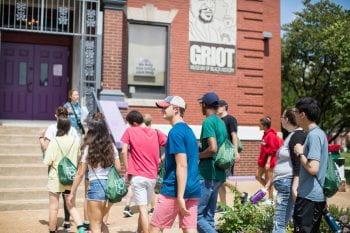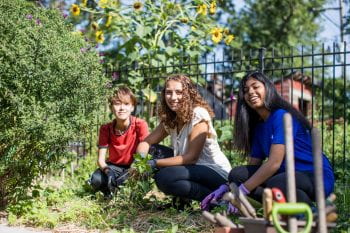
On August 17, 1,736 first-year students arrived to campus weighted down with bags and boxes, nerves and excitement charging the air. Undoubtedly, many wondered about this new place how would they find community and make this campus and city their home. Engage STL, in its inaugural year, attempted to provide support in grappling with questions of purpose, place, and positionality during students’ initial days on campus.
Engage STL is one of several three-day Immersive Experiences, one crucial element of the redesign of the first-year orientation program, Bear Beginnings. The new 9-day program launched this August with the goal of increasing support to students as they make their academic, social, cultural, and personal transition into the WashU and St. Louis communities. The Gephardt Institute for Civic and Community Engagement partnered with the Center for Diversity and Inclusion (CDI) and the Office of Sustainability to plan and implement Engage STL.
During Engage STL, 345 first-year students built relationships, visited neighborhoods, learned from community leaders, participated in excursions, and volunteered with local organizations. The three core topics of the program were community engagement; environmental sustainability; and diversity, equity and inclusion.

One of the unique aspects of the program is the three-way partnership among the Gephardt Institute, the Office of Sustainability, and the CDI. Colleen Smyth, Student Engagement Coordinator at the Gephardt Institute, was the institute’s lead for developing and implementing Engage STL. Colleen noted the importance of the partnership between the three departments, saying that each organization “brought in different perspectives and new ideas to the planning process that made the program stronger.”
Cassie Hage, Sustainability Manager at the Office of Sustainability, and Stephanie Weiskopf, Interim Associate Director of the Center for Diversity and Inclusion, led their respective departments’ involvement in Engage STL (see interviews below). The program’s three themes, represented by the three organizations, are inextricably connected. Learning about civic and community engagement; sustainability; and diversity, equity, and inclusion in conjunction with one another gave students a well-rounded understanding of the three topics’ intersections. Charlyn Moss, class of 2020, one of the Community Assistants for Engage STL alongside Lizze Kehoe, class of 2020, explained, “It’s really easy to get wrapped up in just one of these themes, but being exposed to all three helps students to look through a different lens and see the intersections.”
As the Community Assistants for Engage STL, Lizzie and Charlyn worked alongside professional staff members to organize and oversee the three-day program as well as serve as guides for the upper class group leaders. Colleen explained the essential role played by Charlyn and Lizzie: “The community assistants brought a level of leadership that made the experience what it was. They served as thought partners throughout the way, and the whole process was a deeply collaborative effort.” Learn more about Charlyn and Lizzie here.
Much of the work of relationship-building and individual experience shaping was led by the team of Building Experience and Relationships (BEAR) Leaders, full-time undergraduate students who guided groups of first-year students through their Immersive Experiences. Noor Ghanam, a sophomore studying biology with minors in writing and medical humanities, discussed her experience as a BEAR Leader, describing the process of leading a group through three days of intensive learning and reflection. Although active on campus as a member of GlobeMed exec, a Peer Led Team Learning Leader, and a member of the Muslim Student Association, Noor shared that she felt isolated from the broader St. Louis community before her experience as a BEAR Leader. “I wanted to break out of the bubble,” she explained. “Becoming a BEAR Leader was a way to help other students while learning myself.”
Noor is deeply invested in making the first-year experience valuable for students. “My transition to college was pretty difficult,” she said. “Now that I’m starting my second year, I feel so at home here, and I want to make that transition easier for other students.” Her students communicated key learning experiences to her throughout the program. Some entered with preconceived notions about St. Louis, but by the end of the program, they shared with Noor how grateful they were to be in a city with so much depth and history from which to learn. On one of the excursions, the students visited the George B. Vashon Museum. After spending time learning about the history of the African-American community in St. Louis, Noor said, “The whole dynamic changed. The students were so solemn and thoughtful after a restless morning.” Some of the students’ favorite activities included working outdoors in community gardens and attending the Festival of Nations in Tower Grove Park.
During the program, participants had the opportunity to hear from speaker Rachel d’Souza Seibert of Gladiator Consultant, visit the Griot and the Vashon museums, tour Old North and the Ville, attend community partner panels on a variety of topics, attend the Festival of Nations, learn from Humans of St. Louis, volunteer in community gardens, connect in small groups, and much more.

Engage STL seeks to prepare students to enter their new community of St. Louis in a thoughtful and mutually beneficial manner. Noor encourages first-year and returning students alike to carefully consider intentions before entering a community, asking such questions as, “Am I imposing myself or trying to learn? Will I be making someone uncomfortable? How can I exist in this space? How can I act to demonstrate respect and thoughtfulness?” Noor joked that her students thought she was strict because she didn’t allow phones at any event, but she emphasized how important it is when entering communities to show gratitude and be present. Noor summarized her advice to her group: “Remember that every place has something to offer. You learn, you take, and you give. You can’t walk in thinking you can save a community or help them, because your own community might need the same things in different ways.”
Noor encouraged other students who might be interested in being BEAR Leaders to apply in the spring, even if they think they’re not experienced enough for such a role. “A lot of first years thought I was well-versed in all these issues,” she said, “but I learned just as much as they did.”
Colleen echoed many of Noor’s ideas, explaining the immersive nature of the program: “Students weren’t just doing service. They were digging into the history of neighborhoods in St. Louis and how they show up in community as a WashU student.” Students can continue building on the themes that Engage STL introduced throughout their time at WashU by connecting with the Gephardt Institute, the Office of Sustainability, and the CDI. Learn more about the Gephardt Institute’s programs here.
Read more about the Office of Sustainability and the Center for Diversity and Inclusion in the full interviews with Cassie and Stephanie below.
Stephanie Weiskopf, Interim Associate Director, Center for Diversity and Inclusion
What do you see as the central mission of Engage STL?
I believe the central mission of Engage STL is to bring first-year students together in a learning space centered on themes of social justice, community engagement, and sustainability. The learning landscape includes dialogue with peers, in and with the city of St. Louis, and on campus programming.
Why is Engage STL an important experience for first-year students?
Immersive experience programs are an important experience for all first-year students. They are critically placed right after the academic segment of orientation to build on a growing comfort in the WashU community. To be able to build that comfort and ways of knowing in a direction that aligns with a first-year student’s values and interests is really important. Engage STL, being one of the immersive experiences available to first-year students, demonstrates a strong commitment to the university’s values and the types of dialogue and experiences we hope and expect students to engage in while at WashU.
What was the main role of the CDI in planning and providing this experience?
The CDI was an active partner on the Engage STL planning team alongside the Gephardt Institute and Office of Sustainability. Our Training and Education Specialist and their talents were activated in the development of some of the curriculum facilitated throughout the program.
How can students stay connected with the CDI?
The Center for Diversity and Inclusion supports and advocates for undergraduate, graduate, and professional students from underrepresented and/or marginalized populations, creates collaborative partnerships with campus and community partners, and promotes dialogue and social change among all students. Our work enhances and strengthens Washington University’s commitment to diversity and inclusion. Students who are curious about and/or strongly align with our mission and scope should stop by our new location – Danforth University Center, Suite 150. Learn more about the CDI here.
Cassie Hage, Sustainability Manager, Office of Sustainability
What do you see as the central mission of Engage STL?
The purpose of Engage STL is to provide first-year students with an introduction and fast-track to engage deeply with their new home. It will spark their curiosity and ignite passion to pursue social and environmental justice. It connects dots and fosters interdisciplinary thinking at a much earlier point in the student experience than they would otherwise receive.
Why is Engage STL an important experience for first-year students?
The Engage STL experience helps students “find their people” much earlier, allowing them to do more with the time they have at WashU. It is individually enriching but also aims to build critical mass within the student body so they can do more together and multiply their impact.
What was the main role of the Office of Sustainability in planning and providing this experience?
The Office of Sustainability provided a lens of environmental impact, including an operational perspective (how the program was run), an introduction to the culture of sustainability at WashU, and content that helped connect the dots between human well-being, social justice, and environmental health. The three host organizations balanced one another, pushed each other’s boundaries, and held each other accountable. Personally, I learned a lot through the planning process, thanks to the grace and patience of my partners!
How can students stay connected with the Office of Sustainability?
The best way is to read the monthly newsletter (subscribe on our website), which highlights a wide variety of news and events. Subscribe here.
What else do you want to make sure is included in this story?
Throughout training and in presenting the opportunity to participate in Bear Beginnings programming, I emphasized the opportunity provided by working with such a large number of students. We exceed a tipping point ratio of exposure to these concepts by engaging with 300+ students. Over the next 4 years, as more waves of incoming students participate in the programming, we will have a real critical mass of students with the potential to move the needle on these topics. I am hopeful about what this means for WashU and for the St. Louis region!